If Count Nikolai Pavlovitch Ignatiev was disconcerted to find a powerful enemy before him, he gave no indication of it to his subordinates, but confidently offered battle. However, he did order the hasty construction of field works - enough to cover his infantry and guns. Prompt upon the morning of 21 May 1875, the Turcowaz array surged forward, their right flank rather outpacing their centre and left...
The forces engaged were as follow.
Turcowaz: Kars Command
Army Command, Staff and HQ: Abdul Abulbul Ameer (Average) 6SP
4th Division: HQ (3SP elite), 37th, 38th, 39th, 40th Regiment @ 4SP (poor) = 19SP
5th Division: HQ (3SP elite), 41st, 42nd, 43rd, 44th Regiment @ 4SP (poor) = 19SP
6th Division: HQ (3SP elite), 45th, 46th, 47th, 48th Regiment @ 4SP (poor) = 19SP
X Machinegun Battalion = 2SP (average)
2nd Cavalry Brigade: 21st, 22nd, 23rd Cavalry @ 2SP = 6SP
V, VI/ 3rd Mountain Artillery @ 2SP (average) = 4SP
101st, 102nd Medium Transport Battalion @ 1SP /2CP (carrying capacity) = 2SP/4CP
113th, 114th Pack Transport Battalion @ 1SP /2CP = 2SP/ 4CP
Totals:
26 units, median = 13. Units activated per turn = 12/13/14
79 Strength Points (SP): Army Exhaustion Point -27SP; Rout Point -40SP

Izumrud-Zeleniya Kavkaz Corps |
| Граф Никола́й Па́влович Игна́тьев |
Corps HQ: General-Major Graf N. P. Ignatieff (Good*) = 6SP
2nd Rifle Division:
HQ (3SP elite), 5th, 6th, 7th, 8th Regiments (Average) @4SP = 19SP
2nd Light Cavalry Division:
5th, 6th, 7th, 8th Regiments (Average) @3SP = 12SP
2nd Mountain Artillery Regiment:
I, II Battalions (Average) @2SP = 4SP
Train:
5th Medium Transport; 1st, 2nd Pack Transport columns (Poor) @1SP/2CP = 3SP/6CP
Totals:
15 Units; Median = 8. Units activated per turn = 8/9/10 ('Good' Commander)
44 SP: Army Exhaustion point -15SP; Rout Point -22SP
Some notes:
1. I've taken this commander from G. MacD. Fraser's portrayal of the Russian diplomat and plenipotentiary in his Flashman books (Flashman at the Charge, Flashman and the Great Game). In my world, he fulfils a similar role, but more as a military man on the fringes of the Czar's empire.
2. Although the cavalry are grouped as a Division, they have no Divisional HQ as such, the units (stands) operating more or less independently.
3. The infantry of Izumrud-Zeleniya were armed with rifles; the Turcowaz Bashi-Bazouks with muskets. The superiority of the rifles' range rarely, if ever, came into play, and even then with only trivial results.
4. There is a slight change to the Turcowaz and Zeleniyan transport columns. I'm not 100% sure yet what the carrying capacity really signifies - I have a bit of an idea, and will sort that as I go along.
5. The artillery and MG transports (limbers), being integral to the artillery units, don't have a separate SP or CP allocation.
6. The existence of the transport columns will actually contribute towards the flexibility of these forces, as in general, they are not likely to want to move unless and until the army wishes to withdraw from the field.
7. After considerable thought I've settled upon subcommanders (commanders of Divisions, say) at 3SP each. Like the Army command this is nominal and goes to Army morale, and not to the fighting ability of the element.

I think the above map will help orient the reader as to events - I find it helps in interpreting the photographs. The Izumrud-Zeleniyan left flank was thrown forward to cover the river crossings at the bridge ('
Вуди Бридж' - 'Woody Bridge' it became known as) and the farm. The cover afforded therein were augmented by earthworks, as were the positions of the remaining foot units. Sixth Rifle regiment covered the main Tbilisi highway approaches to the town, whilst the 5th occupied a tongue of woodland to the south. Between the two, the mountain artillery Ist Battalion covered the road and the fields directly to their front. The cavalry, split into equal halves, covered the flanks. Ignatieff was uncomfortably aware that his line was rather thin, and he lacked reserves, apart, perhaps, from the small brigade of cavalry standing on the ridge far to the left.

Abdul's battle on the right.
For his part, the Turcowaz commander tended to mass on his right flank, his early main effort directed to the river crossings where he hoped to seize or carry the farm and the woods on the far bank. Two whole Divisions, backed by V Artillery Battalion, were entrusted with this task. The early probing assaults brusquely swatted back, the Turcowaz began pressing between the defended strongpoints, eventually surrounding both on three sides.Three regiments of Turcowaz 5th Division attacked the farm from three sides, 42nd directly across the river, 41st and 43rd from right and left. Meanwhile, the lead regiment of 6th Division, the 45th, had by now attempted to storm the village, to be sharply driven off by the garrison. As that unit fell back down the road, the 44th from 5th Division took up the attack on the town.

Outnumbered three to one, the 7th (Zeleniya) Rifles were soon enough chivvied out of the farm, and out of the woods behind almost immediately afterward. They fell back to where the minor north road exited the town. The 7th could congratulate themselves that they had at least exacted a steep toll for the 5th Division's passage over the river - 4SP, for just one of its own.
With less room to coordinate its bridge assault, 4th Division was, to begin with, finding to going a deal tougher. The capture of the farm made things easier, and within a short time the lead elements of 4th Division had pushed forward alongside 41st Regiment, to face the Zeleniyan light cavalry on the ridge. The 7th Light Cavalry came to the aid of 8th Rifle Regiment's withdrawal, but even with the close support of II Artillery Battalion, the Zeleniyan line was being strained to the limit.
The strain was to increase. The 44th Bashi-Bazouk Infantry had meanwhile forced their way into the undefended northeastern quarter of the town, there to fetch up on the flank of the battered 7th Regiment. Once more the 7th was forced to fall back. The town itself had meanwhile fallen (of which more anon), and it seemed plain the battle was already lost.
 |
The Turcowaz have taken the town, and the
Izumrud-Zeleniya corps driven back |

The battle was indeed lost - certainly in this part of the field. The further withdrawal of 7th Rifles as far as the entrenched gun line has pretty much unhinged the Zeleniya ridge position. Covered by cavalry counter attacks, the Zeleniyans pulled out: the guns first, the infantry and then the cavalry. Putting some distance between themselves and the oncoming enemy (
they won a vital initiative roll) the Zeleniyan left flank quit the field.
The Battle in the Centre.
The 45th Regiment having been driven back from the face of the town, defended by 6th Rifles with the Division Commander, General-Major I.I. Bondarevsky, the cudgels were taken up by the following Regiment, the 46th. The 44th of 5th Division also struck the place, and found an undefended quarter, with the result already related.
It took a rather long time for the 47th and 48th Regiments to close up upon the right of the Zeleniyan line - a problem for the 46th, assailed in flank by defenders' gunfire.
All the same, at fearful cost the 46th successfully broke into the town. In the running fight through the streets, General Bondarevsky was felled by a musket shot, and 6th Rifles finally driven out the western end of the town. (In writing up the foregoing, it occurred to me that it might have been a good idea to place the defending elements astride two squares. The defence is more difficult, as more attackers could be brought to bear, but it does to some extent obviate the flank attacks that proved the undoing of 7th Rifles).
As the town fighting raged on, 47th Infantry closed upon the enemy mountain guns. The momentum of the wild Bashi-Bazouk charge could not be stopped, even with Count Ignatieff directing the defence. Already weakened by some accurate Turcowaz gunfire early in the action, the surviving half of Ist Artillery battalion fell back to the road. The Bashi-Bazouks followed up. Despite the presence of a road, the artillery were caught tangled in the trees of the wood through which it it passed. Few were the survivors who fled the scene, and half the battalions guns were left on the field.

This victory left 47th Bashi-Bazouk Infantry badly depleted (1SP left). The 48th still being some distance to the rear - barely within musket-shot, withal, that left the 47th somewhat isolated. The 5th Rifles were not going top let this opportunity go by. A sudden increase in the volume of rifle and musket fire from the town encouraged the 5th Rifles as much as it discouraged the 47th.
The artillery having been destroyed, pretty much, Graf Ignatieff joined the defeated 6th Rifles. Delivering himself of a blisteringly short speech, he led the fired-up 6th into a counterattack into the village. It was at once successful, recovering the southwestern quarter. Although both 46 and 47th were then to hold for a time against the powerful counter-offensive, their depleted ranks were too far outnumbered by the Zeleniyans. The 6th bayoneted the 46th out of the town, whilst the 5th recaptured the gun position, though there were no artillery to reoccupy it.
So few were the remnants of the two regiments that fled the place, Abdul Abulbul Ameer after the battle seriously considered disbanding 46th and 47th Regiments both. But before their demise they had both performed very well...
The recapture of the town, a glorious success in itself, did not constitute a victory in the battle as a whole. It really bought valuable time that the trains could be withdrawn safely before the army began its retreat. The retreat proceeded apace, covered by 5th Rifles, occupying and holding the town.
...


Left - The Cavalry Battle:
The Turcowaz light cavalry brigade, comprising three rather weak Mamluk regiments (good {average} fighters, but 2SP cavalry), seeming about the equal of the Zeleniyan cavalry facing them (2 units only, average, but 3SP each), both sides seemed eager to try conclusions. The result turned out to be some desultory skirmishing and general milling around, with not much result. Neither could fling back the other side in order to fall upon the enemy flank.

It was true that late in the day, one of the Turcowaz light cavalry units (21st Mumluk) was destroyed, but 5th and 6th Zeleniyan light horse each lost a strength point. Honours even, then.
Once it became clear that the battle at large was lost, the Zeleniyan Horse drew back to the ridge line behind them at about the moment the 5th and 6th Rifles were winning their counter assaults around the town. Then, with one more bound, they formed a loose line southwest of the town. The remaining picture tell the story.
This was an undoubted Turcowaz victory - the success of the Izumrud-Zeleniya counterattacks around the town notwithstanding. The Zeleniyan Corps had reached its exhaustion point - or very close to it - and the Turcowaz, whatever their losses were, were still full of vim and vigour.
 |
A mistake, here. The Mamluk Horse showing 1SP ought to have been
eliminated. I'd taken the counter-die away to remind me... |
It turned out that Turcowaz losses actually exceeded the Izumrud-Zeleniyan - some 19SP against 15SP. But against that calculation had to be set the guns the Turcowaz captured or destroyed. Now, I like to translate SP into numbers as they might be 'in the real world'. Readers who might recall the Blackland War may remember that as a very sizeable series of operations - a war of nations. This is something rather smaller. As, apart from Army Command, the numbers of figures per element (except artillery which we'll count as 2 figures, and transports and command elements as 1 apiece) equals the strength points of the element, it is a simple matter to count up the figures. One figure represent 500 troops; one gun element represents 1000 men and 40 guns:
Izumrud-Zeleniya:
44SP -> 37 figures ~ 18,500 troops
Artillery: 4SP ~ 2000 men and 80 guns
Turcowaz:
79SP -> 68 figures ~ 34,000 troops.
Artillery: 4SP ~ 2000 men and 80 guns.
Battle losses in SP are halved in the reportage of men and guns lost, so the 19SPs lost to the Turcowaz comes to 9.5SPs ~ 4,750 officers and men. Rounding the SPs returns 10SPs to the army against the 19 lost - a net campaign loss of 9 figures.
The Izumrud-Zeleniya situation is a tad more complicated. They lost 15SP. Battle casualties are reported as 3,750. Eight (7.5SP rounded up) SPs are returned to the Army. However, 3 of those SPs were lost when General Bondarevsky bit the dust. Not only that, but 2SPs were lost to the artillery. The 8SP to be returned will have to be allocated:
3SP to replace the 2nd Division Commander
2SP to replace 4SP infantry lost
2SP to replace 4SP cavalry lost
1SP to replace 2 Artillery lost.
In effect, on top of the 3,750 battle casualties, Count Ignatieff's corps lost 20 of their guns.

Abdul Abulbul Ameer enjoyed his evening hookah smoke with a certain sense of satisfaction: a victory to begin the campaign was always a good augury...
To be continued: After the battle...



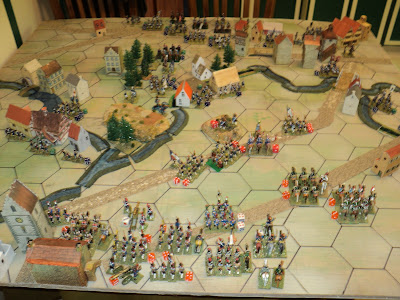




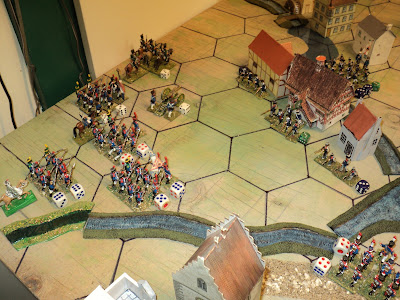





.jpg)







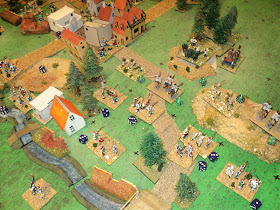
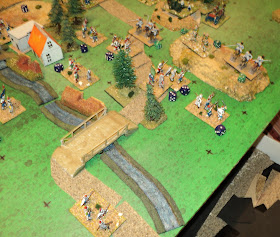

















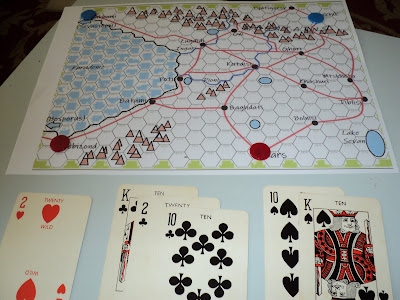






.png)




